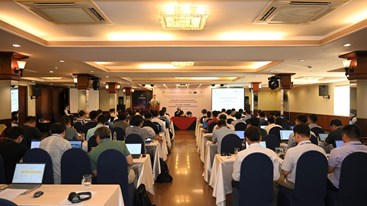Friday, 17/05/2024 | 13:46 GMT+7
Intimex Thanh Chuong Tapioca Factory, under Nghe An Intimex branch, was put into operation in 2004. The factory has increased the capacity twice: from 60 to 120 tons per day and from 120 to 180 tons per day.
Its coal consumption and the rate of raw cassava over
cassava products used to be much higher compared to other factories in

In 2006, the plant used entirely FO oil for the heating process with the norm of 39.766 kilograms per ton of product. In the first five months of 2007, the company used FO oil with the norm of 44.84 kilograms per ton of product; in the next 4 months, entirely used coal with the norm of 140.013 kilograms per ton of product. In 2008, the plant entirely used coal for the heat exchange process; the coal consumption norm was 133.45 kilograms per ton of product. To overcome the heat waste, the company has prepared the cover system to prevent the rain from damping coals and causing loss of volatile, selected coals which have uniform size and reduced the impurities contained in coals, which has helped the company save hundreds of millions of dong.
Coal slags account for a relatively large amount (135 tons per year) and they contain coals which have not been completely burned (about 20% in the slag). This waste is caused by operators, or because coal quality is low and especially, the furnace design is inconsistent with production. To overcome this situation, the plant has improved the furnace to increase the burning capacity to save fuel.
In the past, the company used low efficiency T10 - 40W fluorescent lights with common iron ballasts which caused great line losses. The company has switched to T8 - 36W tube lights (the brightness is 20% higher than T10), equivalent to saving 19.2 kWh per day.
Some electrical contact positions are inappropriate which has caused dephasing leading to waste of power and combustible engine. To overcome this situation, the company has replaced and tightened slack belts in engines and electrical contact positions to avoid the ignition which causes loss of power and burns engines. The company has trained workers to turn off the lights when not in use. In addition, the company has also installed natural lighting panels in the roof to utilize the light and save electricity.
The waste water treatment system of the plant operating under the biolake technology accounts for a relatively large area (about 10 ha). Company's waste water is 1400 m3 per day. The company is currently investing in treatment equipment under UASB technology recovering biogas with the following advantages: not accounting for a large area (accounting for 1/10 of the area of the old system), reducing greenhouse emissions, recovering biogas to replace coal for drying.
The company has signed a contract with EAS (an environment
company of the
The company has set a target of building a waste water treatment system to ensure that waste water will meet the standards; reducing 100% of leakage (water, dust, flour) in intermediate stages of the production process; reducing 10% of coal consumption, 5% of power consumption; reusing waste shell, pulp and residue as fertilizer; optimizing the washing process to save water; controlling as well as evaluating the effectiveness of the implementation of measures to minimize environmental pollution.
By Minh Duc





.png?w=367&h=206&mode=crop)


.jpg?w=367&h=206&mode=crop) Energy efficiency and conservation usage is an important aspect of the national energy development strategy
05/03/2024
Energy efficiency and conservation usage is an important aspect of the national energy development strategy
05/03/2024
 Challenges and Opportunities to promote energy efficiency market in Vietnam
Challenges and Opportunities to promote energy efficiency market in Vietnam
 The Ministry of Industry and Trade requests government agencies to coordinate in organizing Earth Hour 2024
The Ministry of Industry and Trade requests government agencies to coordinate in organizing Earth Hour 2024
 Consultation on Energy Efficiency Boiler Catalogue and Wood Drying Guideline
Consultation on Energy Efficiency Boiler Catalogue and Wood Drying Guideline
.png?w=367&h=206&mode=crop) Request for expression of interest - C2.1.13: Capacity Building on energy efficiency policies development
Request for expression of interest - C2.1.13: Capacity Building on energy efficiency policies development
 Son Ha Co., Ltd, applies energy efficiency and conservation measures
Son Ha Co., Ltd, applies energy efficiency and conservation measures
 Phuc Kien Co., Ltd., is effectively implementing energy-saving measures
Phuc Kien Co., Ltd., is effectively implementing energy-saving measures
 Request for expression of interest - C2.1.12: Independent monitoring of safeguards implementation
Request for expression of interest - C2.1.12: Independent monitoring of safeguards implementation